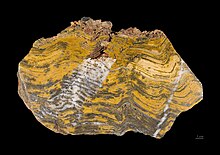Paleoarchean
| Aeonothem | Arathem | system | Age ( mya ) |
|---|---|---|---|
| later | later | later | |
|
A r c h a i k u m Duration: 1500 Ma |
Neo-Archaic Duration: 300 Ma |
2500 ⬍ 2800 |
|
|
Mesoarchean Duration: 400 Ma |
2800 ⬍ 3200 |
||
|
Paleoarchean Duration: 400 Ma |
3200 ⬍ 3600 |
||
|
Eoarchic Duration: 400 Ma |
3600 ⬍ 4000 |
||
| formerly: Hadaikum | |||
The Paleoarchean (derived from παλαιός palaiós "old", thus Paleoarchean = "old Archean") is a geological era . It represents the second of four eras within the geological eon of the Archean . It begins about 3,600 million years ago with the end of the Eoarchean and ends about 3,200 million years ago with the beginning of the Mesoarchean .
Redefinition of the Paleoarchean
In the course of the redefinition of the Precambrian, the Eoarchean should be dropped and replaced by the Paleoarchean. The beginning of the Paleoarchean is therefore shifted forward and now begins at 4030 million years BP . This corresponds to the age of the oldest rock in the history of the earth , the Acasta gneiss in the slave craton . The Paleoarchean is divided into two periods , the older Acastum and the younger Isuum . The boundary between these two periods is chronometrically set at 3810 million years BP, the age of the earliest supracrustal rock in the Isua greenstone belt . The Isuum ends with a first-time GSSP at the base of the Western Australian Dresser Formation at 3490 million years BP. The Mesoarchean then follows. The newly defined Paleo-Archean lasts 540 million years.
meaning
For the first time, crust segments (intensely deformed gneisses ) have been preserved from the Paleoarchean . From 3810 million years BP, the first supracrustal rocks (metavulcanites and metasediments) emerged, in which, despite their degree of deformation, primary structures can still be recognized. This means the beginning of earthly stratigraphy . The first evidence of life in the form of bacteria in the Isua gneiss in Greenland , which has not yet been scientifically proven, also fell in the Paleoarchean .
Occurrence
- Canada:
- Acasta Gneiss - 4030 to 3940 million years BP
- Greenland:
- Itsaq Gneiss Complex - 3870 to 3620 million years BP
- Isua greenstone belt of the Isukasia Terran - 3810 to 3790 and 3710 to 3690 million years BP
- Akilia Association on Akilia Island - around 3850 million years BP (controversial)
-
Labrador :
- Uivak gneiss ; contain as inclusions the supracrustal volcanic rocks of Nulliak (Engl. Nulliak supracrustals ) - 3780 million years BP
-
North Quebec :
- Nuvvuagittuq greenstone belt of the superior craton ( Inukjuak terran of the Ungava peninsula ) - 3780 to 3750 million years BP. A possible age is also given as 3817 ± 16 to 3661 ± 4 million years BP.
-
Australia :
-
East Pilbara Terrane in the Pilbara Craton
- Warrawoona Group - 3525 to 3426 million years BP
- Narryer Gneiss Terran in the Yilgarn Craton - 3730 to 3450 million years BP
-
East Pilbara Terrane in the Pilbara Craton
- South Africa and Swaziland :
See also
Individual evidence
- ^ Felix M. Gradstein, James G. Ogg, Frits J. Hilgen: On The Geologic Time Scale. In: Newsletters on Stratigraphy. Volume 45, No. 2, 2012, ISSN 0078-0421 , pp. 171-188, doi : 10.1127 / 0078-0421 / 2012/0020 .
- ↑ Tsuyoshi Iizuka, Tsuyoshi Komiya, Yuichiro Ueno, Ikuo Katayama, Yosuke Uehara, Shigenori Maruyama, Takafumi Hirata, Simon P. Johnson, Daniel J. Dunkley: Geology and zircon geochronology of the Acasta Gneiss Complex, northwestern Canada: New constraints on its tectonotherern History. In: Precambrian Research . Volume 153, No. 3/4, 2007, pp. 179-208, doi : 10.1016 / j.precamres.2006.11.017 .
- ↑ Nicole L. Cates, Karen Ziegler, Axel K. Schmitt, Stephen J. Mojzsis: Reduced, reused and recycled: Detrital zircons define a maximum age for the Eoarchean (approx. 3750–3780 Ma) Nuvvuagittuq Supracrustal Belt, Québec (Canada) . In: Earth and Planetary Science Letters . Volume 362, 2013, pp. 283-293, doi : 10.1016 / j.epsl.2012.11.054 .
